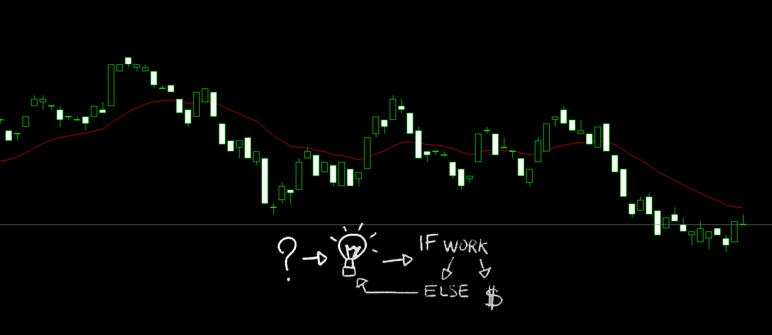How to Create a Winning Trading Plan

The very first step to becoming a successful trader is to write a solid trading plan. But for some reason, most new traders fail to have a trading plan until they’ve blown up a couple of accounts. And, even then many traders don’t take it seriously and say “I’ll do it when I have time”.
So, why is it that so many traders avoid taking the time to write one when it’s so important?
Simply because, in general, human beings don’t like rules!
Let me give you a couple of examples. Do you like having a boss demand you do things at work? How much enjoyment did you gain from your parents disciplining you because you broke their rules when you were a child? Need I go on?
So now you’re in the trading world… a world effectively without limitations (except those dictated by your broker), and you’re free to do whatever you feel like. For the first time in your life you don’t have to adhere to the rules that you’ve previously been bound by.
Trading Plan? What’s that?
Think of your trading plan as the building plans for your house. They’re concise, precise and descriptive instructions of how to build a safe and sturdy home.
A trading plan can be a difficult and daunting task, consisting of what to do before and after a trade, telling you when you should trade, how you should trade, how you should exit a trade and more. And while the writing itself isn’t difficult, being detailed and concise in the simplest manner possible, is indeed a challenging task.
Also, you’re not done with your trading plan once you’ve written it. Au contraire, you need to revise and evolve your plan as your Forex skills improve and you identify tweaks to your edge or weaknesses in your strategy. You need to stay open to revisions!
How to Put a Trading Plan Together
Ok, so now we’re going to go through the framework of putting together a robust trading plan.
Step 1
First, define your strategy. It doesn’t matter what your strategy is, assuming you’ve got an edge of some kind, but this will define things such as do you trade in trending markets, ranging markets, what’s your entry signal, etc… for example, you could refer to our 50% pinbar strategy as discussed here.
Step 2
Now, the time frame. A simple component but that doesn’t belittle its significance. Define the time frames from which you’ll be trading. Failing to pay this step the respect it deserves can result in a fair bit of financial pain. That means don’t flick willy-nilly from the 4 hour chart to the 1 minute, too’ing and fro’ing out of boredom. Choose one or two that you’re most comfortable with and don’t stray.
Step 3
The third component is defining your watchlist. This is key to ensuring that you’re not constantly missing your setups. Your watchlist will change over time, but when starting out you might want to stick to 5-10 symbols, which should provide you with a good amount of setups each week or so. As you find yourself becoming more comfortable monitoring 5-10 symbols you can expand to 15-20 symbols or so.
Step 4
Next, get your mindset right. This means mentally preparing for trading, often another neglected component of a trading plan. Most people don’t like to talk about their feelings because of bravado, or whatever, but this is an absolute MUST DO for trading success. You’re familiar with the poker phrase ‘on tilt’ I assume? Well, guess what, that’s a mental flaw. Ask yourself a quick couple of questions every day you trade such as, “How do you feel today?”, “Is there anything stressing you out?”, “Did you sleep well?”, etc. Habitually take notes of how you feel mentally and emotionally and you’ll very quickly notice patterns that will influence your trading behaviour, and start to establish methods that help overcome these mental hurdles. You also might want to include a set of criteria where if you’re not feeling mentally prepared to face the markets, you just sit this session out. The markets aren’t going anywhere so don’t sweat taking a day off to recoup. After all, staying in cash is a position too.
Step 5
What about your risk? Defining your risk first involves setting your risk threshold as a percentage. Personally, I’d suggest somewhere in the realm of 2-5%, but this is something that you need to define yourself. To start, let’s take an arbitrary $10k account and assume you’re risking 2% each trade. That means that if the trade goes against you the loss will be $200.
Step 6
Now, let’s talk about your R-multiple (read more about r-multiples here). This is your risk reward ratio. So using our 2% risk as discussed above, with a 2R multiple, you’d be risking $200 to make $400. I wouldn’t go for anything less than 2R, but again, that’s entirely up to you. It goes without saying that the higher the better.
Step 7
Ok, let’s get into your entry and exit rules. How are you going to enter your trades? Again, let’s use our 50% pin bar example where we enter when price retraces after a pinbar.
What about your exits? This can often be a bit more complicated as there are a few more ‘moving parts’ so to speak. You’ll have to not only decide your stop loss, but your profit targets as well. Also, will you be closing your full position at those targets, or only half, leaving the other half open to try and take advantage of a larger move?
Step 8
Now for the final component… your post trade analysis. This is how you truly evolve and refine your strategy and grow as a trader. Say for example after a losing trade you may feel the need to exact ‘revenge’ on the market in an attempt to make back the money you’ve lost. Usually revenge trading is caused by either the feeling of invincibility and arrogance or as if the profit from previous trades is now ‘found money’. Let me tell you a little tip to combat this silly behaviour. Your trading profits are NOT found money. When you close a trade at a profit, this is your new balance. You are starting from the start every time you close a trade, whether in profit or loss, so don’t get into the habit of thinking you’re $400 profit gives you an extra $400 balance to play with.
The purpose of your Forex trading plan is for it to be read each day and refined as your skill refines. Make sure you keep it to around a page, maximum and keep it somewhere easily visible and reachable from your trading desk.
Fast & easy account opening
-
Register
Choose an account type and submit your application
-
Fund
Fund your account using a wide range of funding methods.
-
Trade
Access 300+ CFD instruments across all asset classes on MT4 / MT5
That's it, it's that easy to open a Forex and CFD trading account.
Welcome to the world of trading!
open live account








